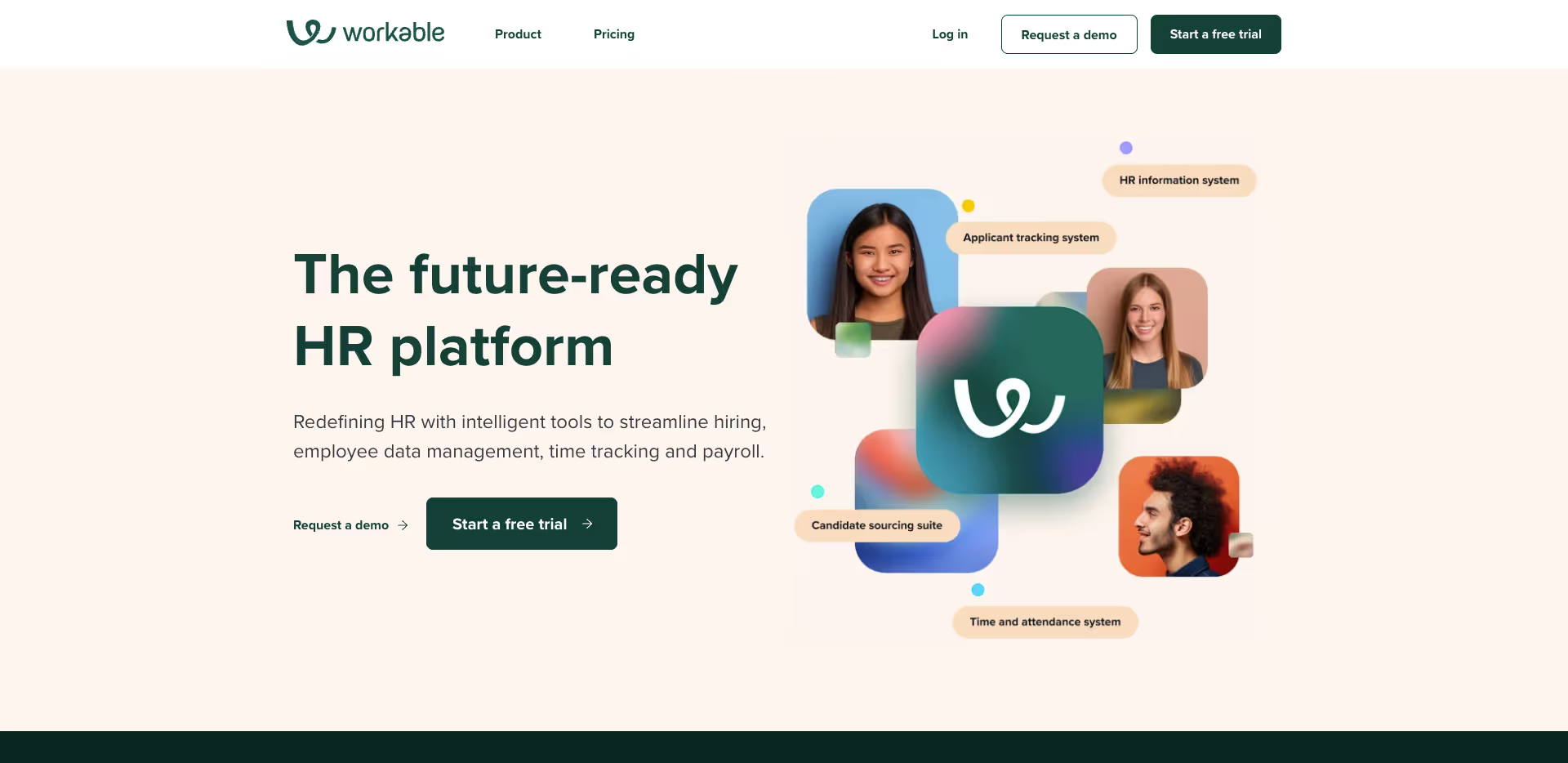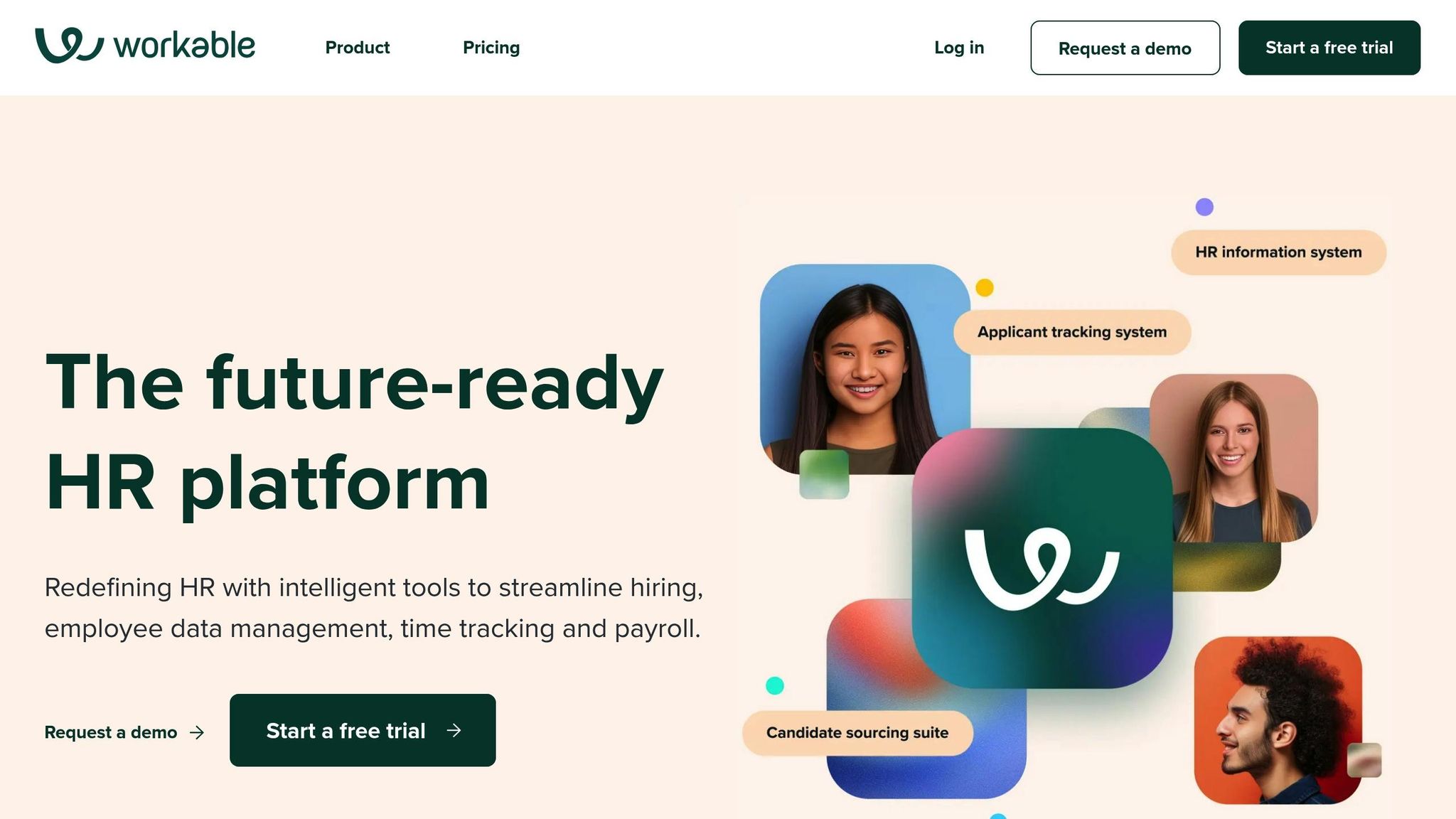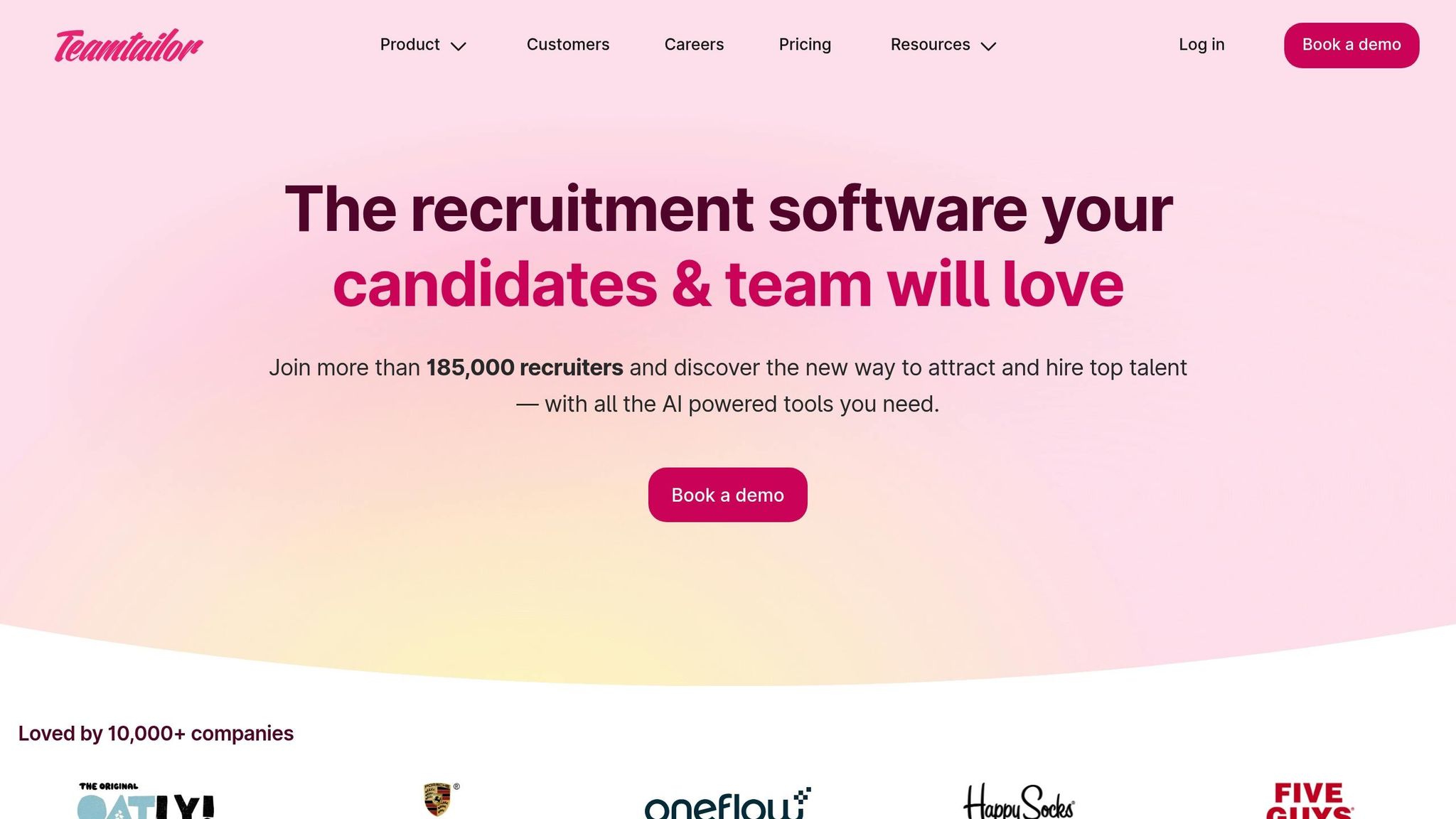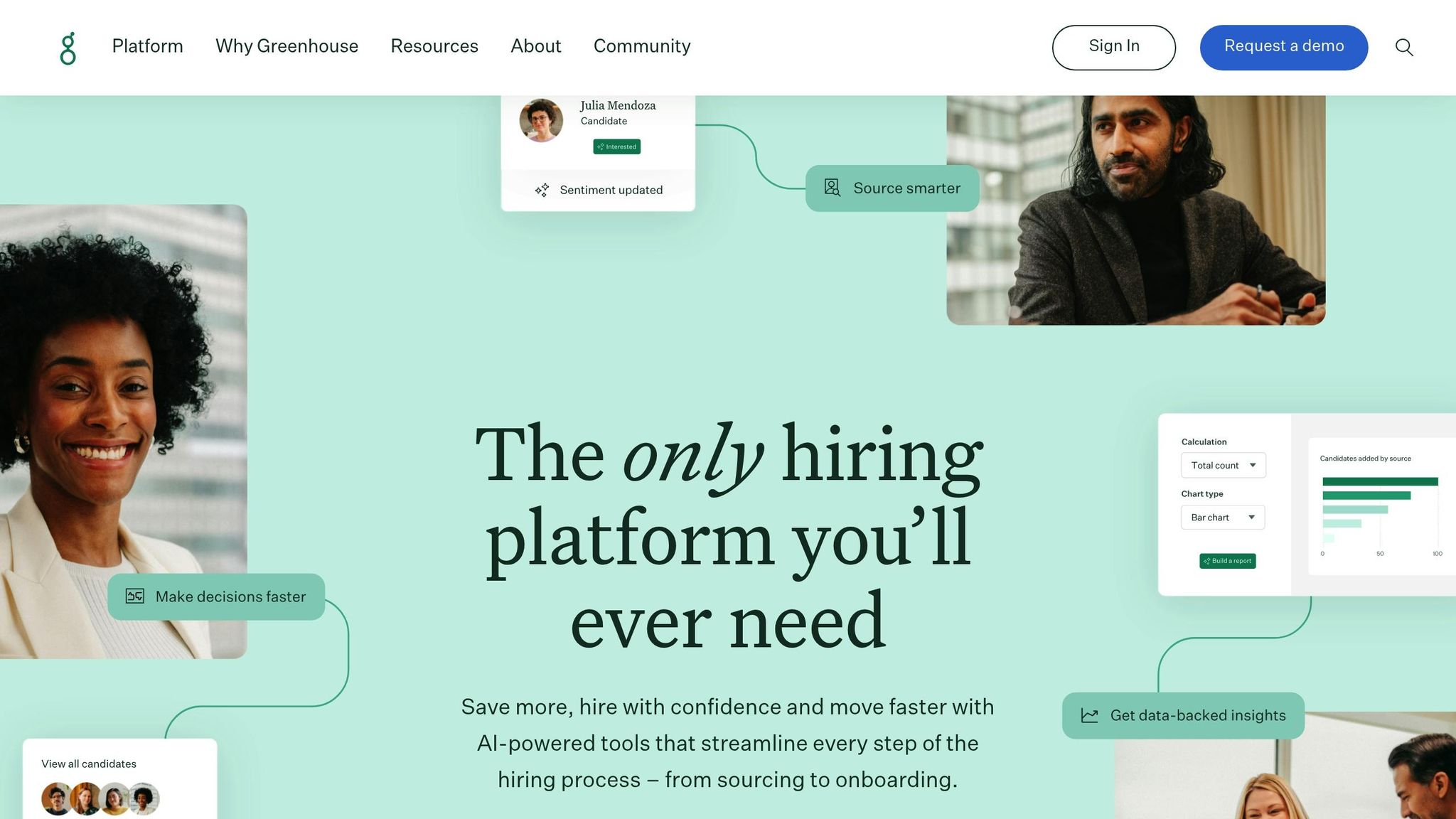Workable Review 2026: A Deep Dive Into Features, Pricing, and Competitors

Looking for the right hiring platform? Here's a breakdown of Workable and its competitors to help you decide. Workable is a recruitment tool tailored for businesses managing 10 to 500+ hires annually. Its standout features include AI-driven candidate sourcing, job board integrations, and video interview tools. However, pricing and limited analytics on lower tiers may not suit all budgets.
Key Takeaways:
- Workable: AI sourcing, job postings to 200+ boards, and collaboration tools. Pricing starts at $149/month but scales up for advanced features.
- Teamtailor: Focuses on employer branding with customizable career sites. Pricing is custom and less transparent.
- Greenhouse: Offers structured workflows and compliance tools but comes with a steeper learning curve and higher costs.
- Lever: Combines applicant tracking with CRM features for long-term talent pipelines. Pricing is custom and may feel excessive for simpler needs.
Quick Comparison:
| Platform | Strengths | Weaknesses | Best For |
|---|---|---|---|
| Workable | AI sourcing, user-friendly | High cost, limited analytics | SMBs, mid-sized companies |
| Teamtailor | Employer branding tools | Limited reporting, unclear pricing | Branding-focused companies |
| Greenhouse | Structured workflows, analytics | High cost, complex setup | Large organizations |
| Lever | Candidate relationship focus | Custom pricing, integration issues | Long-term hiring strategies |
Bottom Line: Workable excels for mid-sized teams needing AI automation and integrations, but budget-conscious or small businesses may prefer alternatives like Teamtailor or Lever. Choose based on your hiring volume, budget, and priorities.
Workable Review

1. Workable
Workable is a recruitment platform that blends applicant tracking, candidate sourcing, and HR management into one cohesive solution. Designed to simplify hiring for organizations of all sizes, it offers features that cater to both small teams and enterprise-level needs.
Features
Workable continues to evolve its tools to tackle modern hiring challenges head-on.
One standout feature is its AI-powered sourcing, which automates the process of finding and matching candidates, making it easier to pinpoint top talent. Its applicant tracking system (ATS) is another major strength, offering customizable pipelines tailored to specific roles. Automated workflows ensure candidates move seamlessly through hiring stages, triggered by actions like completing assessments or receiving interview feedback.
The platform also excels in job posting distribution, enabling users to post job openings to over 200 boards, including LinkedIn, Indeed, and Glassdoor, while maintaining consistency across platforms. For interviews, Workable provides tools for both one-way recorded interviews and live video calls.
Collaboration is a key focus, with features like structured scorecards and real-time comments that allow hiring teams to evaluate candidates collectively. A centralized dashboard keeps everything organized, from candidate profiles to interview notes and feedback.
For data-driven teams, Workable's reporting and analytics module tracks metrics like time-to-hire, source effectiveness, and diversity statistics. Users can even create custom reports to identify trends and address bottlenecks in the hiring process.
Pricing
Workable uses a subscription model with three main pricing tiers, designed to fit companies of different sizes and hiring needs:
- Starter Plan: Priced at $149 per month, this plan includes basic ATS tools, job postings to major boards, and support for up to three active users. It's ideal for teams making fewer than 50 hires annually.
- Standard Plan: At $299 per month, this tier introduces AI-powered sourcing, advanced reporting, and integrations with popular HR tools. It supports up to 10 active users and includes monthly AI sourcing credits.
- Premier Plan: Starting at $599 per month (custom pricing available), this option is designed for larger organizations. It includes API access, advanced compliance tools, unlimited AI sourcing, and dedicated customer success support.
All plans come with a 15-day free trial, and pricing adjusts based on active job postings and hiring volume. For businesses with seasonal hiring needs, plans can be scaled up or down as required.
Ideal User Profile
Workable caters to a range of professionals, from HR and recruitment leaders to CEOs and hiring managers. Its account management tools and user access controls make it especially useful for executives who need secure access to sensitive candidate information.
Mid-sized companies juggling multiple job openings across departments benefit greatly from Workable’s collaborative tools and automated workflows. Remote-focused organizations and distributed teams also find value in its cloud-based platform and video interview capabilities, which help manage hiring across time zones.
Strengths & Weaknesses
Workable offers several advantages that make hiring more efficient, though it does have areas where improvements could be made.
Strengths:
- An intuitive interface that simplifies onboarding for new users.
- A robust integration ecosystem, connecting with tools like Slack, BambooHR, and LinkedIn Recruiter.
- Responsive customer support, particularly for those on higher-tier plans.
Weaknesses:
- Pricing may be prohibitive for smaller businesses with tight budgets.
- Lower-tier plans lack advanced reporting features, which might limit organizations that need detailed recruitment insights.
For teams seeking a streamlined, feature-rich hiring platform, Workable delivers a powerful solution, though cost considerations and reporting limitations could influence its appeal for some businesses.
2. Teamtailor

Teamtailor sets itself apart by offering more than just an applicant tracking system - it's a full-fledged recruitment platform that integrates essential hiring tools with features designed to enhance employer branding. With 185,000 recruiters across 10,000+ companies relying on it [1], Teamtailor aims to deliver a smooth and efficient hiring experience.
Features
Teamtailor comes equipped with a Generative AI co-pilot that simplifies repetitive tasks like drafting job descriptions, creating interview questions, summarizing resumes, and organizing meeting notes. This automation helps teams save time and focus on more strategic aspects of recruitment.
The platform also offers robust employer branding tools, enabling businesses to design fully customizable career sites. These sites can include team stories, lead pages, and SEO-focused features to improve visibility.
Other key features include:
- Posting jobs across multiple boards with ease
- Real-time collaboration tools for sharing feedback, scorecards, and candidate evaluations among teams
- A detailed analytics suite that covers job and employee reports, EEO compliance, audience insights, and pipeline tracking
- Integration with over 450 applications, ensuring compatibility with existing HR tools like HRIS systems, Slack, and video conferencing platforms [1]
Pricing
Teamtailor uses a subscription-based pricing model that adjusts based on company size and hiring needs. While specific costs aren’t publicly listed, the platform offers tiered plans tailored for both small businesses and larger enterprises. Pricing often depends on factors like the number of active job postings, AI co-pilot usage, and the level of career site customization. Enterprise plans may include perks such as dedicated Customer Success Managers and priority support.
For a personalized plan, companies can request custom quotes based on their hiring volume and feature requirements. Every plan includes implementation support and onboarding assistance, making it easier for companies to get started. This flexible pricing approach caters to organizations looking to balance efficient recruitment with strong employer branding.
Ideal User Profile
Teamtailor works particularly well for companies that prioritize employer branding alongside streamlined recruitment processes. Businesses that value the ability to create unique, candidate-focused career sites will find this platform especially appealing. Growing mid-sized companies benefit from its scalability, while remote-first or distributed teams appreciate the cloud-based tools that ensure consistent hiring experiences across locations.
Strengths & Weaknesses
Teamtailor has several standout strengths, including:
- A clean, easy-to-navigate interface with a minimal learning curve
- Excellent customer support, featuring quick response times and dedicated success managers
- Generative AI tools that simplify and speed up repetitive tasks
- Advanced employer branding features that naturally attract candidates
- Comprehensive analytics for optimizing recruitment strategies
However, one area for improvement is pricing transparency, as detailed cost information isn’t available without contacting the sales team.
3. Greenhouse

Greenhouse is a hiring platform designed to bring structure and consistency to recruitment. It focuses on creating fair and effective hiring workflows by requiring hiring managers to define clear criteria and scorecards before posting jobs. This approach reduces bias by emphasizing job-relevant skills over subjective factors.
Features
Greenhouse offers a range of tools to streamline recruitment:
- CRM Capabilities: Recruiters can build talent pipelines before job openings arise, with automated candidate nurturing through email sequences and engagement tracking.
- Reporting and Analytics: The platform provides insights into metrics like time-to-hire, source effectiveness, and diversity. Customizable dashboards help identify bottlenecks, while compliance reports for EEO requirements are automatically generated.
- Integration Options: Greenhouse supports custom integrations through its API, enabling connections with HRIS systems, background check providers, assessment tools, and communication platforms.
These features align with Greenhouse’s mission to promote structured, bias-reduced hiring practices.
Pricing
Greenhouse uses a custom pricing model, meaning companies must consult with the sales team to get a quote [2]. Pricing is divided into three tiers - Essential, Advanced, and Expert - and scales based on company size and feature needs [4][5][6][7].
Here’s a look at estimated annual costs by company size [2][7]:
| Company Size | Estimated Annual Cost |
|---|---|
| 1-10 employees | ~$6,500 |
| 11-25 employees | ~$8,500 |
| 26-50 employees | ~$7,000 |
| 51-100 employees | ~$10,000 |
| 101-250 employees | ~$15,000 |
| 251-500 employees | ~$23,000 |
| 501-1,000 employees | ~$23,000 |
| 1,000+ employees | From ~$24,500 |
Expect annual price increases of 8-15% during renewals [3]. However, presenting competitive analyses can help secure flat renewals in 71% of cases, potentially saving up to $23,000 over three years [3]. Additional costs may arise for extras like sourcing automation, HRIS integrations, texting capabilities, or audit logs. For instance, Grayscale Texting Pro adds $2,010 to the Expert plan, though negotiating it upfront could save $800-$1,200 annually [3].
Ideal User Profile
Greenhouse is an excellent choice for mid-sized to large organizations that prioritize structured and compliant hiring practices. It’s particularly effective for companies with 50+ employees needing standardized recruitment across multiple departments or locations. This is especially useful in regulated industries where detailed hiring documentation and audit trails are a must. High-growth companies focused on data-driven decision-making will also find value in Greenhouse’s approach.
Strengths & Weaknesses
Greenhouse stands out for its structured interviewing process and detailed reporting tools, which help organizations refine recruitment strategies through data-driven insights. Its robust API ensures seamless integration into existing HR tech stacks.
However, the platform’s custom pricing model and sales consultation requirement can be a hurdle for companies looking for straightforward pricing. Additionally, smaller teams with simpler hiring needs may find the structured processes overly rigid.
Overall, Greenhouse offers a strong option for companies seeking a systematic and compliant approach to hiring, making it a solid contender in the broader ATS market discussed in this review.
sbb-itb-88a7fe6
4. Lever

Lever is a talent relationship management platform that merges ATS (Applicant Tracking System) and CRM (Customer Relationship Management) features. Founded in 2012 and headquartered in San Francisco, Lever focuses on helping companies build long-term talent pipelines rather than just managing active job applications. This makes it especially appealing for organizations that prioritize proactive recruiting and sustained engagement with candidates.
Features
Lever shifts the focus from one-off hiring to maintaining long-term relationships with candidates. Recruiters can track interactions over extended periods, with the platform storing detailed communication histories and engagement records.
The platform integrates with LinkedIn to automatically sync candidate profiles. Its email sequencing feature allows recruiters to set up automated, personalized follow-ups for passive candidates, ensuring consistent communication over time.
Collaboration is another standout feature. Hiring managers can design custom interview kits with standardized questions and evaluation criteria. Lever also simplifies interview scheduling across multiple team members and gathers structured feedback through standardized scorecards.
For data-driven insights, the analytics dashboard tracks key metrics like pipeline health, outreach response rates, and candidate progression. These insights help recruiters evaluate their strategies and optimize performance.
Pricing
Lever uses a custom pricing model, with details available directly from their sales team. Costs depend on factors such as team size, hiring volume, and selected features. Companies should also account for potential additional expenses, such as implementation and training fees.
Ideal User Profile
Lever works best for mid-sized companies with dedicated recruiting teams that focus on building long-term candidate relationships. It’s particularly well-suited for industries like technology, consulting, and recruiting agencies, including executive search firms that require ongoing engagement with high-value candidates. However, organizations with high-volume or predominantly entry-level hiring needs may find Lever’s relationship management features more than they require.
Strengths & Weaknesses
One of Lever’s biggest strengths is its emphasis on relationship management, making it ideal for roles with longer hiring cycles or competitive talent markets. Its collaborative hiring tools streamline complex interview processes, and users often praise its intuitive interface.
However, the custom pricing model can make budgeting tricky, especially as organizational needs grow. While Lever does offer API access for integrations, some users report challenges when connecting it with specialized HR tools or custom workflows, particularly compared to platforms with a wider range of pre-built connectors. For teams that only need basic applicant tracking, Lever’s detailed relationship management features may feel excessive.
These features and considerations highlight what sets Lever apart, along with its potential limitations, depending on a company’s specific hiring needs.
Advantages and Disadvantages
Here’s a quick rundown of the standout features and challenges for each platform, based on the earlier discussion.
Workable stands out with its AI-driven sourcing tools and broad job board reach, making recruitment smoother and more efficient. On the downside, its pricing can be a bit steep for smaller teams, and advanced analytics are reserved for higher-tier plans.
Teamtailor focuses on enhancing employer branding with customizable career sites. However, it falls short in advanced reporting and can incur extra costs for deeper customization.
Greenhouse excels in structured workflows, compliance tools, and detailed analytics, ideal for complex hiring needs. That said, its steep learning curve and higher costs might be a hurdle for smaller organizations.
Lever prioritizes relationship management and collaboration, which supports long-term hiring strategies. Yet, its custom pricing model and potential integration challenges can make it less appealing for teams with tight budgets.
| Platform | Key Strengths | Main Weaknesses | Best For |
|---|---|---|---|
| Workable | AI sourcing, user-friendly design | High cost, limited reporting | SMBs and mid-market teams |
| Teamtailor | Employer branding, visual tools | Limited reporting, customization costs | Companies focused on candidate experience |
| Greenhouse | Structured workflows, compliance | Steep learning curve, higher cost | Large organizations |
| Lever | Relationship management, collaboration | Custom pricing, integration issues | Recruiting teams with long-term goals |
Choosing the right platform depends on your hiring needs, team size, and overall strategy. Budget constraints and pricing clarity are also key factors to weigh as you narrow down your options. This comparison should help you evaluate the platforms before diving into final recommendations.
Conclusion
When comparing Workable to its competitors, it proves to be a strong choice for mid-sized and remote-first organizations, though it may not meet the needs of every hiring scenario.
Workable shines for mid-sized businesses and remote teams that require AI-powered sourcing capabilities. Its intuitive interface and quick setup make it an attractive option for growing companies aiming to streamline their hiring processes. The platform strikes a good balance between offering advanced tools and maintaining ease of use, which is critical for teams managing ongoing recruitment across various roles. With its AI features and extensive job board integrations, Workable stands out in a competitive market. However, like any platform, it has its limitations.
For instance, Workable is not designed with small businesses in mind. While many might assume it caters to all company sizes, its features and pricing are more aligned with the needs of larger organizations [8]. This positions it in direct competition with platforms like Greenhouse, which also targets mid-sized to enterprise-level companies, rather than competing with budget-friendly options for smaller businesses.
Ultimately, choosing the right platform depends on your organization’s specific priorities. Companies prioritizing employer branding and a seamless candidate experience might prefer Teamtailor, while those needing structured, compliance-focused workflows may opt for Greenhouse, despite its steeper learning curve. On the other hand, businesses focused on building and maintaining long-term relationships with candidates may benefit more from Lever's CRM-driven approach.
That said, Workable's pricing could be a challenge for teams with low hiring volumes, and the fact that advanced analytics are only available at higher subscription tiers might be a drawback for data-focused organizations on tighter budgets.
Before committing, consider your hiring needs, team size, and growth trajectory. Workable is best suited for established companies ready to invest in a comprehensive recruiting solution, rather than startups just beginning to explore applicant tracking systems.
FAQs
What makes Workable stand out compared to other recruitment platforms?
Workable has become a go-to platform in 2026, thanks to its AI-driven sourcing tools. These tools simplify the process of finding and matching candidates to open roles, saving recruiters time while ensuring access to top talent. The platform also serves as an all-in-one solution, combining essential HR functions like applicant tracking, onboarding, and payroll into a single, integrated system.
Some of its standout features include multi-channel job posting, which allows recruiters to post listings to over 200 job boards, and real-time analytics that provide insights into hiring performance. Additionally, its automation tools help streamline workflows, making it an excellent fit for fast-moving, modern recruitment teams.
What pricing options does Workable offer for businesses of different sizes and hiring needs?
Workable's pricing in 2026 is structured to accommodate businesses of all sizes, offering three distinct plans: Starter, Standard, and Premier. Each plan is crafted to align with different hiring needs and organizational goals.
- Starter: Priced at $169/month, this plan is perfect for small businesses or teams with occasional hiring requirements.
- Standard: Starting at $299/month, this plan caters to mid-sized companies with steady hiring demands.
- Premier: At $599/month, this plan is tailored for larger organizations needing advanced features and strategic hiring tools.
Pricing may adjust based on factors like company size, hiring volume, and chosen features, ensuring businesses can find a plan that works for their unique needs.
What types of businesses are best suited for using Workable's recruitment platform?
Workable is a solid choice for small to mid-sized businesses (SMBs), recruiting agencies, and remote-first companies aiming to simplify and automate their hiring process. With AI-driven sourcing, easy-to-use collaboration tools, and an intuitive interface, it’s particularly well-suited for teams juggling multiple job postings across various locations.
Larger organizations can also take advantage of Workable’s features, like its extensive integration options and detailed analytics. However, businesses needing highly tailored enterprise-level solutions may find other platforms a better match. For teams focused on streamlining workflows and adopting modern recruitment tools, Workable stands out as an efficient option.
Related Blog Posts
Read also
Ready to get started?
If you want to dive into the details just Book a Free Consultation with our staff and we’ll be happy to answer your questions.





